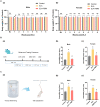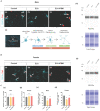Photobiomodulation attenuates oligodendrocyte dysfunction and prevents adverse neurological consequences in a rat model of early life adversity
- PMID: 36793860
- PMCID: PMC9925323
- DOI: 10.7150/thno.78777
Photobiomodulation attenuates oligodendrocyte dysfunction and prevents adverse neurological consequences in a rat model of early life adversity
Abstract
Rationale: Adverse experiences in early life including abuse, trauma and neglect, have been linked to poor physical and mental health outcomes. Emerging evidence implies that those who experienced early life adversity (ELA) are more likely to develop cognitive dysfunction and depressive-like symptoms in adulthood. The molecular mechanisms responsible for the negative consequences of ELA, however, remain unclear. In the absence of effective management options, anticipatory guidance is the mainstay of ELA prevention. Furthermore, there is no available treatment that prevents or alleviates the neurologic sequelae of ELA, especially traumatic stress. Hence, the present study aims to investigate the mechanisms for these associations and evaluate whether photobiomodulation (PBM), a non-invasive therapeutic procedure, can prevent the negative cognitive and behavioral manifestations of ELA in later life. Methods: ELA was induced by repeated inescapable electric foot shock of rats from postnatal day 21 to 26. On the day immediately following the last foot shock, 2-min daily PBM treatment was applied transcranially for 7 consecutive days. Cognitive dysfunction and depression-like behaviors were measured by a battery of behavioral tests in adulthood. Subsequently, oligodendrocyte progenitor cells (OPCs) differentiation, the proliferation and apoptosis of oligodendrocyte lineage cells (OLs), mature oligodendrocyte, myelinating oligodendrocyte, the level of oxidative damage, reactive oxygen species (ROS) and total antioxidant capacity were measured and analyzed using immunofluorescence staining, capillary-based immunoassay (ProteinSimple®) and antioxidant assay kit. Results: The rats exposed to ELA exhibited obvious oligodendrocyte dysfunction, including a reduction in OPCs differentiation, diminished generation and survival of OLs, decreased OLs, and decreased matured oligodendrocyte. Furthermore, a deficit in myelinating oligodendrocytes was observed, in conjunction with an imbalance in redox homeostasis and accumulated oxidative damage. These alternations were concomitant with cognitive dysfunction and depression-like behaviors. Importantly, we found that early PBM treatment largely prevented these pathologies and reversed the neurologic sequelae resulting from ELA. Conclusions: Collectively, these findings provide new insights into the mechanism by which ELA affects neurological outcomes. Moreover, our findings support that PBM may be a promising strategy to prevent ELA-induced neurologic sequelae that develops later in life.
Keywords: Cognition; Depression; Early life adversity (ELA); Oligodendrocyte; Photobiomodulation (PBM).
© The author(s).
Conflict of interest statement
Competing Interests: The authors have declared that no competing interest exists.
Figures









Similar articles
-
Early life adversity as a risk factor for cognitive impairment and Alzheimer's disease.Transl Neurodegener. 2023 May 12;12(1):25. doi: 10.1186/s40035-023-00355-z. Transl Neurodegener. 2023. PMID: 37173751 Free PMC article. Review.
-
Photobiomodulation Therapy Attenuates Anxious-Depressive-Like Behavior in the TgF344 Rat Model.J Alzheimers Dis. 2021;83(4):1415-1429. doi: 10.3233/JAD-201616. J Alzheimers Dis. 2021. PMID: 34219711
-
Sex differences in stress-induced visceral hypersensitivity following early life adversity: a two hit model.Neurogastroenterol Motil. 2016 Dec;28(12):1876-1889. doi: 10.1111/nmo.12891. Epub 2016 Jul 7. Neurogastroenterol Motil. 2016. PMID: 27385091
-
Early life adversity and depressive symptoms predict cortisol in pregnancy.Arch Womens Ment Health. 2020 Jun;23(3):379-389. doi: 10.1007/s00737-019-00983-3. Epub 2019 Jul 9. Arch Womens Ment Health. 2020. PMID: 31289940 Free PMC article.
-
Sex Differences in Affective Dysfunction and Alterations in Parvalbumin in Rodent Models of Early Life Adversity.Front Behav Neurosci. 2021 Nov 4;15:741454. doi: 10.3389/fnbeh.2021.741454. eCollection 2021. Front Behav Neurosci. 2021. PMID: 34803622 Free PMC article. Review.
Cited by
-
Photostimulation of lymphatic clearance of β-amyloid from mouse brain: a new strategy for the therapy of Alzheimer's disease.Front Optoelectron. 2023 Dec 14;16(1):45. doi: 10.1007/s12200-023-00099-8. Front Optoelectron. 2023. PMID: 38095816 Free PMC article.
-
Enhancing axonal myelination: Clemastine attenuates cognitive impairment in a rat model of diffuse traumatic brain injury.Transl Res. 2024 Jun;268:40-50. doi: 10.1016/j.trsl.2024.01.008. Epub 2024 Jan 19. Transl Res. 2024. PMID: 38246342 Free PMC article.
-
Oligodendrocyte progenitor cells in Alzheimer's disease: from physiology to pathology.Transl Neurodegener. 2023 Nov 14;12(1):52. doi: 10.1186/s40035-023-00385-7. Transl Neurodegener. 2023. PMID: 37964328 Free PMC article. Review.
-
Early life adversity as a risk factor for cognitive impairment and Alzheimer's disease.Transl Neurodegener. 2023 May 12;12(1):25. doi: 10.1186/s40035-023-00355-z. Transl Neurodegener. 2023. PMID: 37173751 Free PMC article. Review.
-
Unlocking the potential of photobiomodulation therapy for brain neurovascular coupling: The biological effects and medical applications.J Cereb Blood Flow Metab. 2025 May;45(5):800-830. doi: 10.1177/0271678X241311695. Epub 2025 Jan 7. J Cereb Blood Flow Metab. 2025. PMID: 39763390 Free PMC article. Review.
References
-
- Thumfart KM, Jawaid A, Bright K, Flachsmann M, Mansuy IM. Epigenetics of childhood trauma: Long term sequelae and potential for treatment. Neurosci Biobehav Rev. 2022;132:1049–66. - PubMed
-
- Gilgoff R, Singh L, Koita K, Gentile B, Marques SS. Adverse Childhood Experiences, Outcomes, and Interventions. Pediatr Clin North Am. 2020;67:259–73. - PubMed
Publication types
MeSH terms
Substances
Grants and funding
LinkOut - more resources
Full Text Sources

